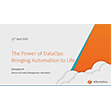
The Automotive Market Pivots Hard to Generative AI and the Metaverse

(Chesky/Shutterstock)
NVIDIA held its GTC conference in March, and much of the content had to do with how the automotive market is rethinking the 300+ new factories it will be building to create the next generation of electric, self-driving cars, trucks and flying vehicles. Generative AI and the metaverse will potentially provide a customization capability that hasn’t been seen since the beginning of the automotive industry when cars were more custom-built than line-built. I expect this advancement to improve customer retention, customer satisfaction, reliability, and performance and to substantially reduce market failures. Other industries will embrace these technologies, as well, for similar reasons.
Let’s talk about how generative AI and the metaverse is already resulting in a massive change in future car and truck factories and how the related companies will engage more deeply with and become much closer to their users.
The Metaverse from Cradle to Grave
Typically, cars are conceived as ideas. These ideas are then winnowed down into a couple of concepts. The concepts are made into clay models and circulated for comment. Prototypes are built and taken to car shows and tested on private then public roads. Focus groups are brought in to see if there is a market for the car. This process can take over five years, generally doesn’t anticipate what the competitive market will be when the car is released, and often lacks enough customer voice throughout the process. The result is that cars sell poorly once they come out. In addition, during line setup, problems are often discovered late in the process which delays manufacturing and incurs otherwise avoidable costs to redesign and reconfigure the lines. 
The metaverse (mostly NVIDIA Omniverse which is dominant in automotive) is increasingly being used by a wide variety of car makers to not only design and receive feedback on the new car, but to virtually design factories and their manufacturing floors to assure that major parts of the new or existing factory won’t need to be redone and potentially reduce time-to-market significantly.
In addition, the metaverse is being used to design and get feedback on the car, which eliminates the problems associated with configuring the lines because those problems can now be identified in the metaverse. This allows for less costly corrections should they be necessary.
A digital twin of the car is created that allows the buyer to not only build the car they want but allows them to follow the car through the build process and address any questions about the choices they made. This digital twin will remain tied to the car. It will help the user fix some things and enable the user to not only better discover potential problems but help them fix them if they are remote from a dealer. The car company can follow the life of the vehicle in order to understand and address points of failure that might otherwise arise later and damage its relationship with the user.
Generative AI at the Heart of the Customer Relationship
These next generation cars are slated to have generative AI interfaces that enable the driver to converse with their vehicle in natural language as opposed to packaged and irritating fixed commands. This conversational interface has already spread through Microsoft’s developer tools and most recently through Windows, Office, and the Edge browser. Even though Google was caught sleeping, this interface should quickly spread across its platforms, as well. This means we’ll be surrounded increasingly by things that we can use natural language to interface with.
The implication is that, over time, car owners will interface with their car and car company through generative AI and develop more of a collegial relationship with their vehicles and car companies. These AIs will not only help users learn about their new vehicles and how to operate them, but help them select the right vehicle and configuration before they buy the car. In addition, I expect this will evolve to a point where we will first interface with our generative automotive AI during the purchase process and be able to apply the most successful upselling capabilities while balancing the need to maintain a trusted relationship between the buyer and the related car company.
Instead of interacting only when the buyer has a very serious problem or during the buying process, future buyers will stay engaged through the generative AI with their car company. I also expect this generative AI experience won’t just be in the car but will extend into the home and business as users demand a more consistent AI experience across an ever-widening field of products much like we saw with tools like Apple’s Siri and especially Amazon Alexa. But car companies are already pulling the plug on these third-party tools in favor of their own to embrace their customers and tie them more tightly to the company by addressing the customer retention problem.
Wrapping up:
Automotive companies appear to be racing ahead of everyone else to apply metaverse and generative AI to their products and factories. But the benefits of this move, which include speed to market, fewer mistakes, better reliability, better performance and higher customer satisfaction and customer loyalty, will spread to other industries. Generative AI efforts will consolidate to approach the goal that users will likely prefer of having only one generative AI interface into all their smart products. This suggests future market expansions for automotive companies that will want to partner with or buy into related markets that will benefit from the automotive companies’ leadership as they leverage the user’s need for a consistent AI experience.
In short, while the metaverse and generative AI will hit the automotive market hard at first, once the benefits are validated, they will rapidly spread to other markets and change every aspect of how we design, build, monetize and service products and how these companies create and maintain a deeper relationship with customers. 
About the author: As President and Principal Analyst of the Enderle Group, Rob Enderle provides regional and global companies with guidance in how to create credible dialogue with the market, target customer needs, create new business opportunities, anticipate technology changes, select vendors and products, and practice zero dollar marketing. For over 20 years Rob has worked for and with companies like Microsoft, HP, IBM, Dell, Toshiba, Gateway, Sony, USAA, Texas Instruments, AMD, Intel, Credit Suisse First Boston, ROLM, and Siemens.
Related Items:
Wired vs. Unwired and the Coming Massive Changes in IoT Provisioning
Wrapping our Heads Around CES 2023 and Next Generation Applied AI
In the Shadow of the Twitter Acquisition-Layoff Disaster: How to Prepare for Layoffs
February 14, 2025
- Clarifai Unveils Control Center for Enhanced AI Visibility and Decision-Making
- EDB Strengthens Partner Program to Accelerate Postgres and AI Adoption Worldwide
- Workday Introduces Agent System of Record for AI Workforce Management
- Fujitsu Unveils Generative AI Cloud Platform with Data Security Focus
- NTT DATA Highlights AI Responsibility Gap as Leadership Fails to Keep Pace
- Gurobi AI Modeling Empowers Users with Accessible Optimization Resources
February 13, 2025
- SingleStore Unveils No-Code Solution Designed to Cut Data Migration from Days to Hours
- Databricks Announces Launch of SAP Databricks
- SAP Debuts Business Data Cloud with Databricks to Turbocharge Business AI
- Data Science Salon Kickstarts 2025 with DSS ATX Conference, Featuring AI Startup Showcase
- Hydrolix Achieves Amazon CloudFront Ready Designation
- Astronomer Launches Astro Observe to Unify Data Observability and Orchestration
- EU Launches InvestAI Initiative to Build AI Gigafactories Across Europe
- HPE Announces Shipment of Its First NVIDIA Grace Blackwell System
- IDC Celebrates 60 Years of Tech Intelligence at Directions 2025
- Lucidity Gains $21M to Scale AI-Driven Cloud Storage Optimization
- Glean Launches Open Security and Governance Partner Program for Enterprise AI
February 12, 2025
- OpenTelemetry Is Too Complicated, VictoriaMetrics Says
- What Are Reasoning Models and Why You Should Care
- Three Ways Data Products Empower Internal Users
- Memgraph Bolsters AI Development with GraphRAG Support
- Keeping Data Private and Secure with Agentic AI
- Three Data Challenges Leaders Need To Overcome to Successfully Implement AI
- PayPal Feeds the DL Beast with Huge Vault of Fraud Data
- Top-Down or Bottom-Up Data Model Design: Which is Best?
- Inside Nvidia’s New Desktop AI Box, ‘Project DIGITS’
- Data Catalogs Vs. Metadata Catalogs: What’s the Difference?
- More Features…
- Meet MATA, an AI Research Assistant for Scientific Data
- AI Agent Claims 80% Reduction in Time to Complete Data Tasks
- DataRobot Expands AI Capabilities with Agnostiq Acquisition
- Collibra Bolsters Position in Fast-Moving AI Governance Field
- Snowflake Unleashes AI Agents to Unlock Enterprise Data
- Observo AI Raises $15M for Agentic AI-Powered Data Pipelines
- Anaconda’s Commercial Fee Is Paying Off, CEO Says
- Microsoft Open Sources Code Behind PostgreSQL-Based MongoDB Clone
- Confluent and Databricks Join Forces to Bridge AI’s Data Gap
- Mathematica Helps Crack Zodiac Killer’s Code
- More News In Brief…
- Informatica Reveals Surge in GenAI Investments as Nearly All Data Leaders Race Ahead
- Gartner Predicts 40% of Generative AI Solutions Will Be Multimodal By 2027
- PEAK:AIO Powers AI Data for University of Strathclyde’s MediForge Hub
- DataRobot Acquires Agnostiq to Accelerate Agentic AI Application Development
- TigerGraph Launches Savanna Cloud Platform to Scale Graph Analytics for AI
- EY and Microsoft Unveil AI Skills Passport to Bridge Workforce AI Training Gap
- Alluxio Enhances Enterprise AI with Version 3.5 for Faster Model Training
- DeepSeek-R1 models now available on AWS
- Lightning AI Brings DeepSeek to Private Enterprise Clouds with AI Hub
- SAS Viya Outperforms Competitors and Lowers Operational Costs, Study Says
- More This Just In…




























